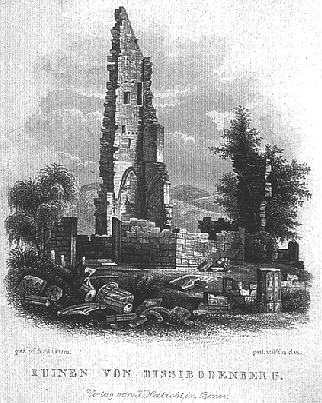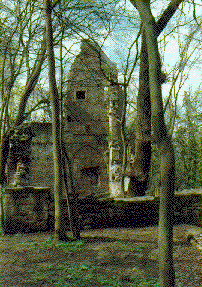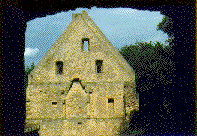The Disibodenberg


Ruin of the convent of Disibodenberg
left:
Engraving by Winkles approximately 1840,
after a drawing by C. Schlikum,
Although a visitor of the Disibodenberg today finds only ruins as testimonies of a great and important religious past, the almost solemn atmosphere of this place will impress him and will take him under its spell. For it is here, where Hildegard spent most of her lifetime.
Since the 7th century at the latest, the Disibodenberg, located at the confluence of the rivers Nahe and Glen, had been a centre of Christian life, assumedly already a sanctuary in pre-christian times. The baptistery built on the mountain became the starting-point of the missionary work in the Nahe-region. Missionaries from already christianized regions came to this land, among them Disibod, who built a cell for himself on the mountain, which later was named after him, and according to the tradition Hildegard refers to in her Disibod-biography he even erected a monastery. It is documented before the 9th century already that Disibod was venerated as a Saint. About the turn of the millennium, Archbishop Willigis of Mainz founded next to the Baptistery on the Disibodenberg a canon-convent for twelve clergymen, who were to take pastoral care for the surrounding settlements. In 1108, Archbishop Ruthard of Mainz summoned Benedictine monks from the Abbey of St. Jacob in Mainz to the Disibodenberg and, in the same year, a new monastery was built, the imposing dimensions of which can still be imagined from the well-preserved ruins. Young Hildegard could watch with her own eyes these building activities, which may have given her impulses for the later construction of her monastery on the Rupertsberg. In accordance with the customs of that time, a nun's cell was adjoined to the monks' monastery on the Disibodenberg. Only vague suppositions can be made today about the exact location of this cell in the area of the monastery, since the excavations have not been finished yet. Jutta of Sponheim was the first to live as a recluse in this cell. Young Hildegard and two of her companions were entrusted to her for education. From a hitherto unknown biography of Jutta, who was beatified later, conclusions can be drawn about the spirituality Hildegard was formed by in her youth. Beside her religious formation, Hildegard most likely also received a broad and varied intellectual education. Benedictine convents at that time were strongholds of art and science. And as the monk Volmar was at Hildegard's side giving her scholarly advice, it is likely that the monks of the Disibodenberg introduced her to the complex world of Benedictine tradition. Her life's work gives evidence of her universal education, which finds its expression in regard of theology, nature, medicine, her cosmic view, world and humankind, in her compositions and numerous letters. During the years between 1112 and 1115, Hildegard made the decision to live in the monastery for good, taking the vows of the Benedictine order. In her biography, Bishop Otto of Bamberg is mentioned in this context. He represented at that time the interests of the diocese, since Archbishop Adalbert I. of Mainz had been taken prisoner by the imperial government. In 1136 Jutta of Sponheim, the "Mistress" of the women hermitage on the Disibodenberg, died. Hildegard was elected 'unanimously" - as is documented - her successor by the community, counting ten women at that time.
The year 1141 brought a decisive event in the life of the new Mistress of the Disibodenberg. When she was "42 years and 7 months of age" - as she herself notes precisely - she fully experienced the breakthrough of what she called her "vision". Since early childhood Hildegard had been gifted with an exceptional intuition. Now she was almost seized by the fire of the Divine Spirit, as a miniature in her first work SCIVIAS tries to depict the situation, and in this light she saw the "living light" ' Not with her physical eyes and ears did she experience this vision, but inwardly with an alert mind, her physical eyes open and outside of all ecstasy. This kind of vision places her in one line with the Old Testament prophets, like them receiving the same instruction: "Write down what you are seeing and hearing!" Only reluctantly Hildegard followed this demand. In 1141 she began writing down her first theological visionary work SCIVIAS, which was finished in 1151. As again and again she was overcome by doubts during this work, she turned to Abbot Bernard of Clairvaux for advice, who first reacted reservedly. Eventually, he supported Hildegard's scriptures of her visions at the synod of Trier in 1147/48 in the presence of Pope Eugene 111. in such a way, that the latter himself, after having examined the texts, read them aloud to the assembled cardinals. Thus he acknowledged the seer, who later was entitled "Prophetissa teutonica", and encouraged her to further scriptures. The monastery of the Disibodenberg, too, may have profited a little from the "splendor" of this papal acknowledgment.
At the same time, the separation of the monks' monastery and the nun's convent was initiated. In 1147, Hildegard decided - despite all difficulties - to leave the Disibodenberg with her nuns - another proof of her inner independence. Various reasons may have motivated her for this decision, the most important one being the lack of space for her growing convent, consisting of 18 nuns by then. In a vision, Hildegard was allocated the site for the new monastery at the confluence of the Rhine and Nahe, where St. Rupertus once had lived as a hermit. Among the patrons, whose donations made possible the building of the monastery on the Rupertsberg, the Count Palatine Hermann of Stahleck is mentioned first in the Rupertsberg foundation book. Between 1147 and 1151 the nuns moved to their new place, and in 11 52, as is documented, the church and the monastery were consecrated.

 left:
left:
Gable of the hospital, guesthouse, erected after 1400.
right:
Keystone of the chapel of St. Mary, Christ.
To be seen in the museum of the Winery Convent of Disibodenberg.
At Hildegard's departure from the Disibodenberg, first signs of decadence may have become apparent in the monks' convent. When they lead to the decline the Archbishop of Mainz entrusted the convent together with its property to the Cistercians, who could hold out for approximately 300 years. In 1559, the final decline was sealed which could not be undone anymore in spite of many attempts of revival. From the middle of the 18th century the destruction of the buildings began, which first served as a quarry until the grounds were passed over into private hands.
The present private proprietor, Ehrengard Baroness of Racknitz, née Countess of Hohenthal, transferred the former grounds of the convent into a foundation on May 21st, 1989. The SCIVIAS-Foundation of Disibodenberg endeavors to obtain further research programs and the preservation and protection of the ruins as witnesses of a thousand-year-long Christian tradition.
Sr. Teresa Tromberend OSB
Historical Sites



 left:
left: